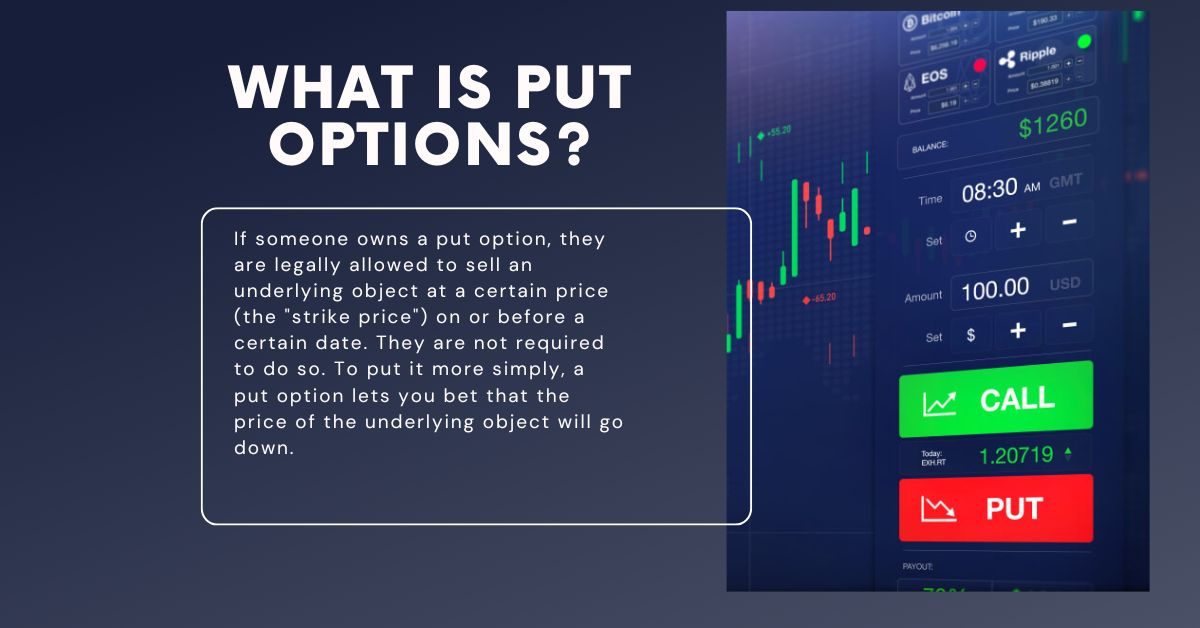Put options are a type of option that rises in value as the stock falls. A put allows the owner to set a specified price for selling a specific stock, while a put seller agrees to acquire the stock at that price. The appeal of puts is that they can appreciate fast on a minor change in the stock price, making them popular among traders wanting to earn large gains quickly.
The other primary type of option is the call option. It is the most well-known sort of option, and its value rises as the stock rises.
What is Put Options?

If someone owns a put option, they are legally allowed to sell an underlying object at a certain price (the “strike price”) on or before a certain date. They are not required to do so. To put it more simply, a put option lets you bet that the price of the underlying object will go down.
You can sell the asset at the higher strike price and make a profit if the price of the asset goes below the strike price. If the price of the asset goes above the strike price, on the other hand, the option is no longer valuable, and you lose the premium you paid for it.
How a Put Option Works?
Take the example of believing that the price of a certain stock, XYZ, will go down. You buy a put option for XYZ with a $50 strike price and a one-month end date. This means that before the date of expiration, you can sell XYZ at $50 per share, no matter what its market price is.
You can use your put option to sell your shares for $50 each if the price of XYZ falls to $45 per share before the expiry date. This will give you a profit of $5 per share. If the price of XYZ stays above $50, on the other hand, the option will expire worthless, and you will lose the extra you paid for it.
How to Buy and Sell Put Options?
There are several steps to buying and selling put options:
- Pick out a brokerage: Pick an exchange that lets you trade options.
- Sign up: Open a bank account and put the money you need into it.
- Do research: Pick out the main asset you want to trade, like an index or stock.
- Pick a strike price and a date this contract will end: Find out the date the option expires and the strike price at which you want to sell the commodity.
- Put in an order: Use your brokerage tool to put in an order to buy or sell the put option.
Watch the amount of the option: Watch the price of the option as it changes based on the price of the underlying object and the time left until it expires. - Make the choice to sell or exercise: If the option is “in-the-money,” which means the price of the asset is less than the strike price, you can sell the asset at the strike price. You can also sell the option contract itself before it expires to make money or keep your losses to a minimum.
When to Buy a Put Option?
If you think the price of a base asset will go down, you might want to buy a put option. This might be because of things like
- Market drop: If you think the market will drop across the board, getting put options on a lot of different assets can help protect your portfolio.
- News about a specific company: If there is bad news about a company, like a poor earnings report or legal problems, its stock price could go down.
- How to handle risk: Put options can be used as insurance to protect your portfolio against possible losses.
If you already own a stock and are worried that its price might go down, buying a put option on that company can help protect your position.
When to Sell a Put Option?
If you think the price of an underlying product will stay the same or go up, you might want to sell a put option, which is also called “writing a put option.” This might be because of things like
- Positive view for the market: If you think the market will generally go up, selling put options can help you make money.
- Optimism about a specific company: If good news comes out about a company, like a new product or good earnings, its stock price might go up.
- Managing risk: Selling put options is a way to make money, but it also comes with some risk. You might have to buy the underlying object at the price of the strike, even if the price drops a lot. This could mean that you lose money.
Buying a Put Option Vs. Short Selling
| Feature | Buying a Put Option | Short Selling |
|---|---|---|
| Definition | Acquiring the right to sell an asset at a predetermined price. | Selling borrowed securities with the expectation that the price will decline. |
| Risk | Limited to the premium paid for the option. | Potentially unlimited if the stock price rises. |
| Reward | Limited to the difference between the strike price and the asset’s price at expiration. | Unlimited if the stock price declines. |
| Leverage | Limited leverage, as the premium is a fixed cost. | Higher leverage, as the initial investment is smaller. |
| Timing | Can be exercised anytime before expiration. | Must be closed before the expiration date. |
| Costs | Premium paid for the option. | Transaction costs and potential borrowing fees. |
| Suitable for | Investors seeking downside protection or limited risk. | Investors who believe a stock’s price will decline significantly. |
Advantages and Disadvantages of Put Options
| Advantage | Disadvantage |
|---|---|
| Limited risk: The maximum loss is the premium paid for the option. | Time decay: The option’s value decreases over time, even if the underlying asset’s price remains unchanged. |
| Downside protection: Put options can protect against potential losses in a portfolio. | Premium cost: Buying a put option requires paying a premium upfront. |
| Flexibility: Options can be exercised or sold at any time before expiration. | Uncertainty: The outcome of an option trade is uncertain and depends on the underlying asset’s price movement. |
| Hedging: Put options can be used to hedge existing positions. | Limited upside: If the underlying asset’s price rises significantly, the option’s value may be minimal. |
| Speculation: Put options can be used for speculative trading. | Complexity: Options trading can be complex and requires a good understanding of financial markets. |
Is a Put Option Bullish or Bearish?
A put option is a loser. It allows the owner to sell a base asset at a set price, which is profitable if the price of the asset goes down. So, buying a put option means that the investor thinks the price of the underlying object will go down, which is called a bearish outlook.
What Is the Downside of Buying a Put?
The main bad thing about getting a put option is that it might lose all of its value at some point. If the underlying asset’s price doesn’t fall below the strike price before the end date, the option will lose all of its value, and you will lose the premium you paid for it. This is called “time decay,” and it means that the value of the option goes down over time, even if the price of the underlying object stays the same.
Also, put options protect you against losses, but they also limit your possible gains. If the price of the base asset goes up a lot, the option may not be worth much.

